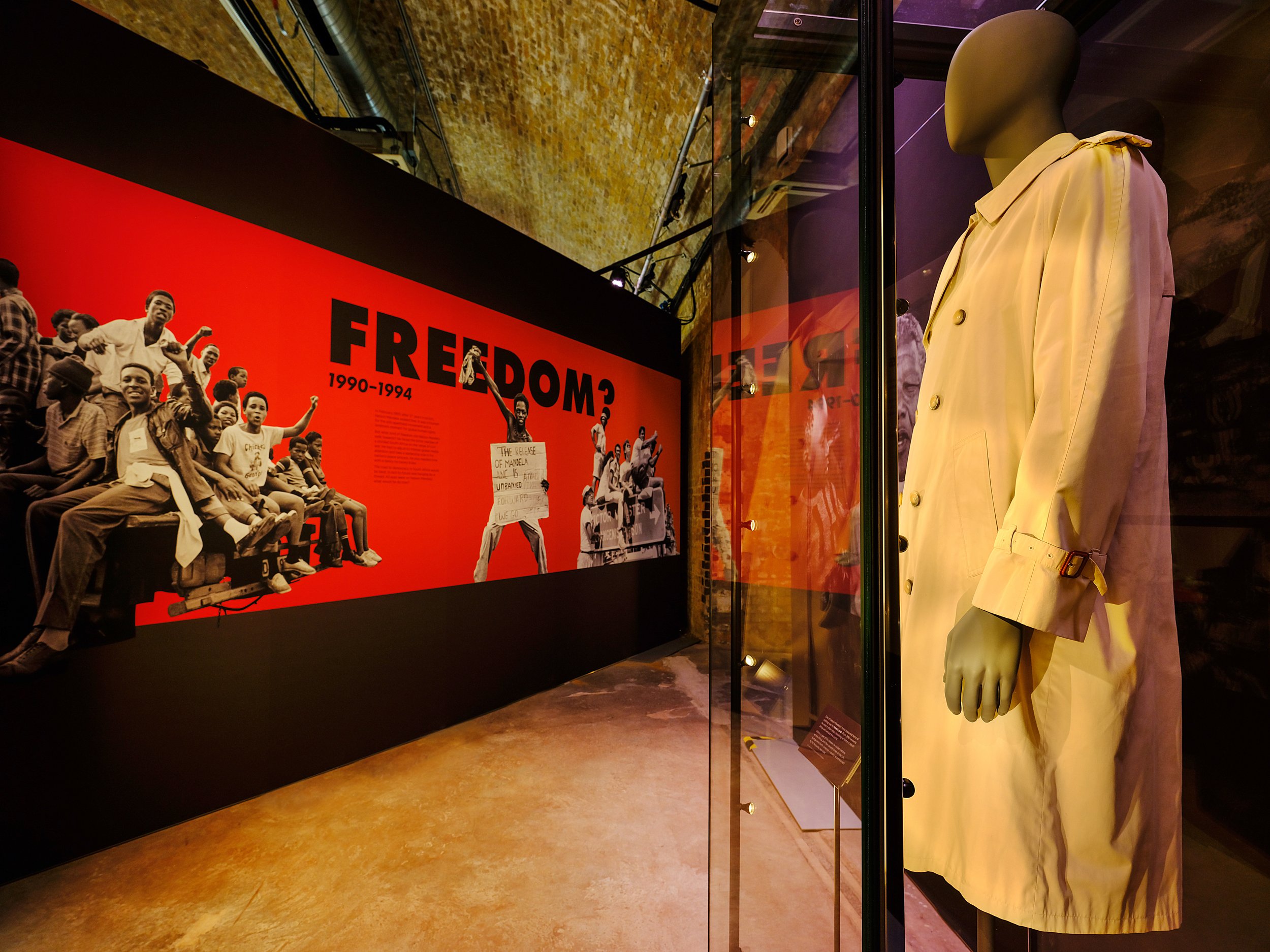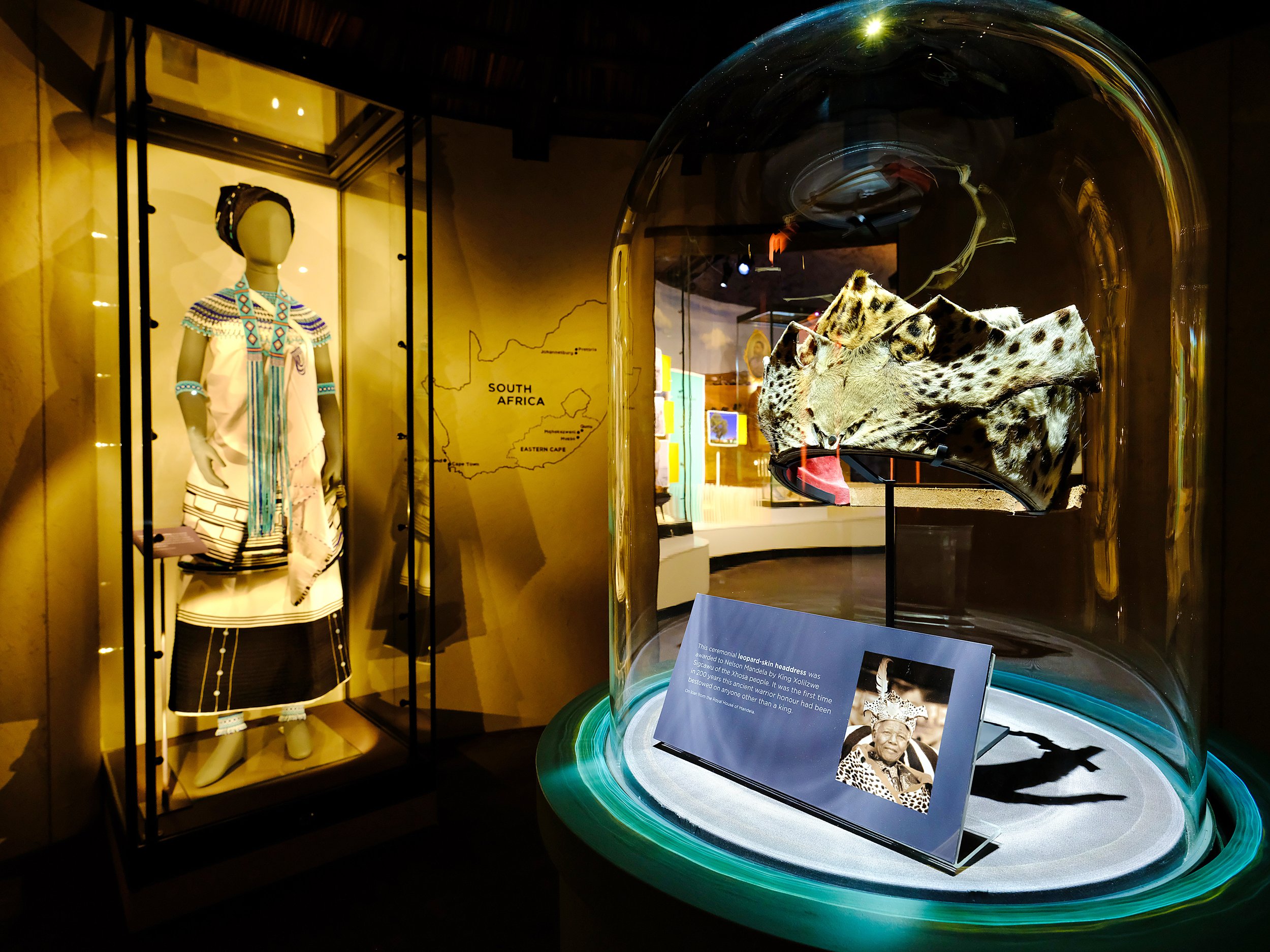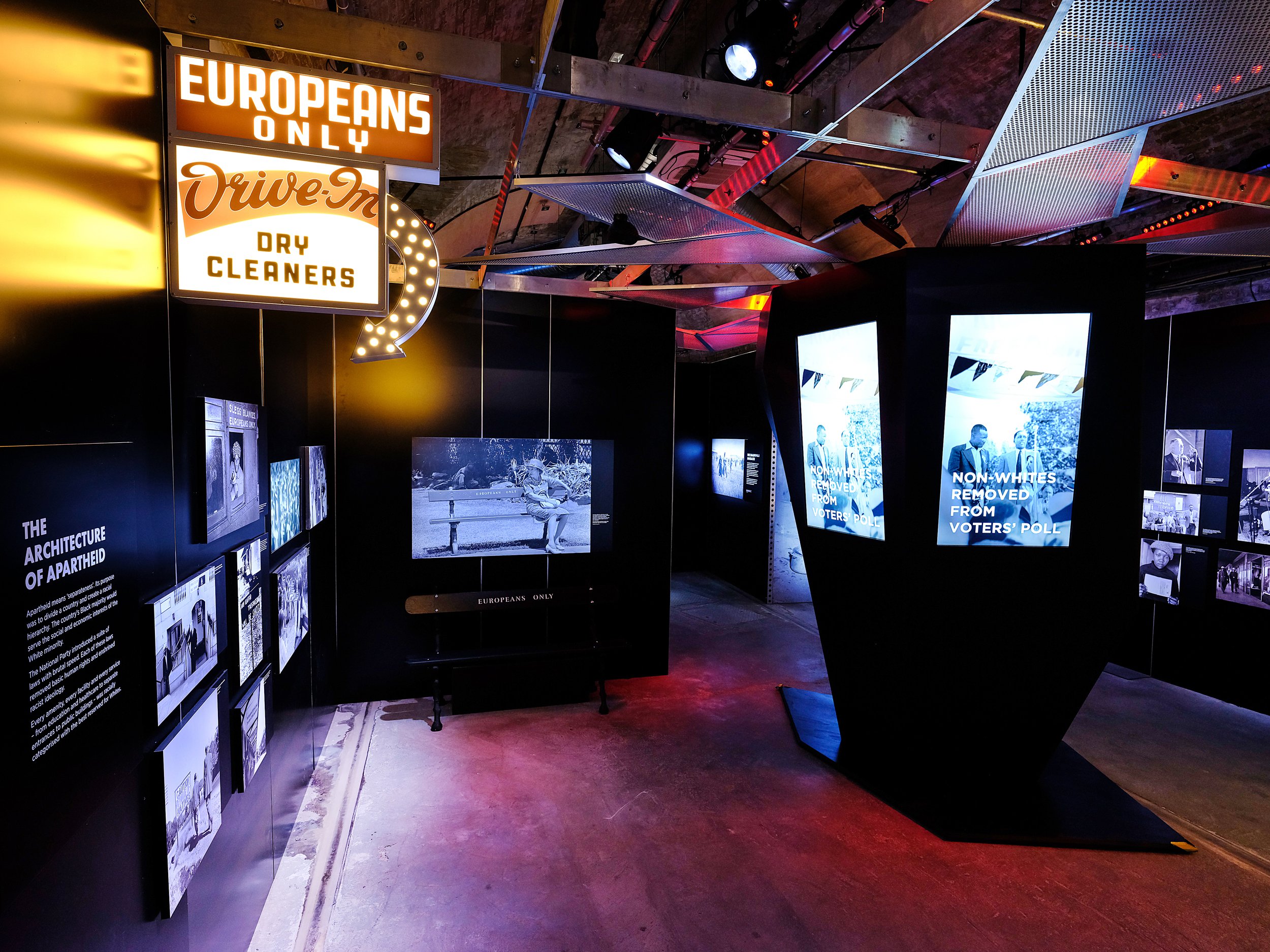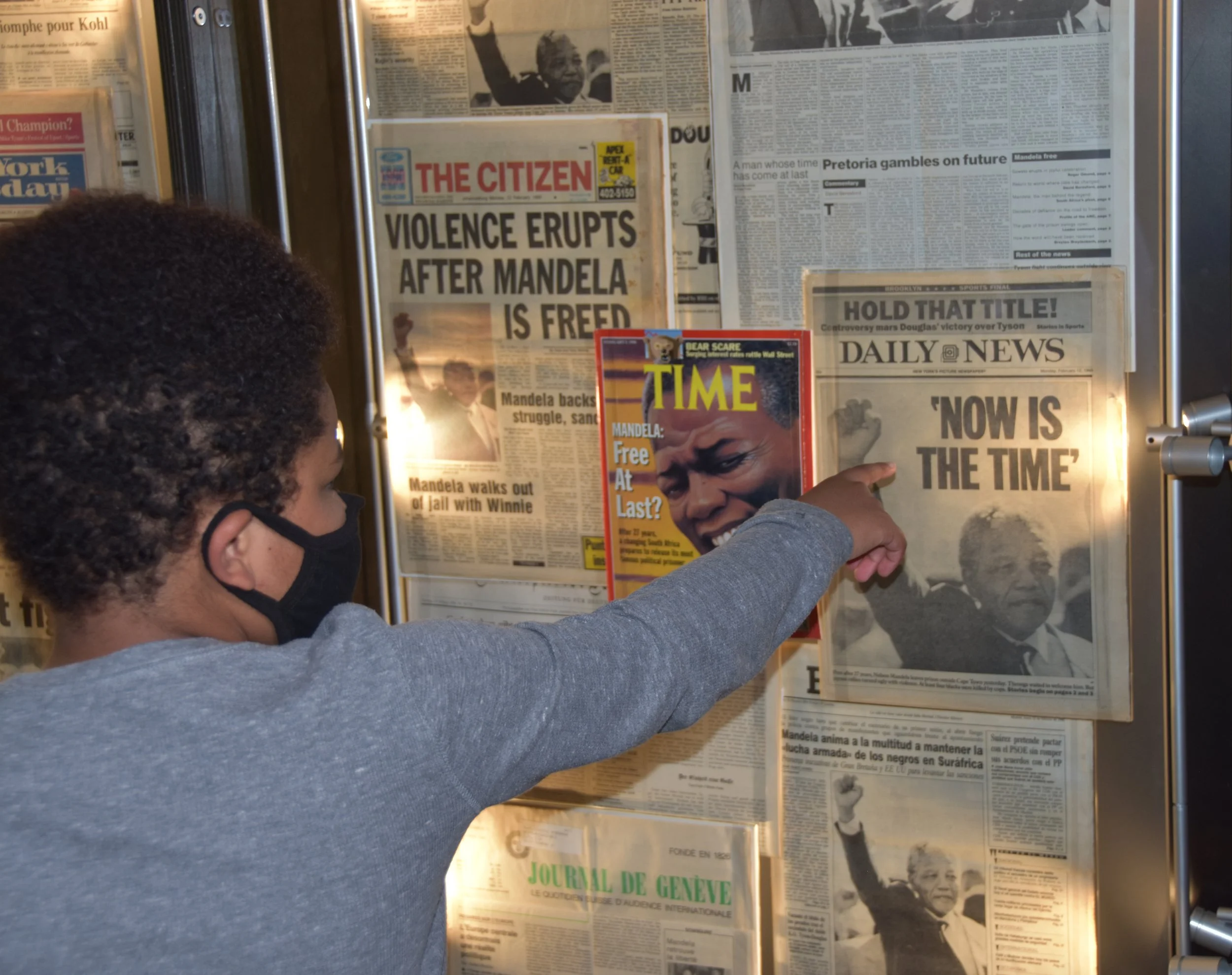Nelson Mandela Exhibit at the Durham Museum Through July 3
A young person points to a New York Daily News cover from the life of Nelson Mandela. Photo credit: Jim Marks
By Jonathan Orozco
“During my lifetime I have dedicated my life to this struggle of the African people. I have cherished the ideal of a democratic and free society in which all persons will live together in harmony and with equal opportunities. It is an ideal for which I hope to live for and to see realised [sic]. But, my Lord, if it needs be, it is an ideal for which I am prepared to die.”
Nelson Rolihlahla Mandela, the first ever democratically elected president of South Africa, said these words in a 1964 court trial that would lead to his 27 year incarceration because of his struggle to end racial and colonial oppression in his home country.
Over 150 historical artifacts and personal effects from the Mandela family, and museums and archives around the world, are on display at the grand biographical exhibition “Nelson Mandela: The Official Exhibition” at the Durham Museum until July 3. This deep dive into Mandela’s life is at times heartbreaking and disturbing, but also joyous and poignant and aspires to leave viewers with a sense of hope that the world’s injustices can be fought and changed.
Photo from “The Meaning of Mandela,” the finale where Nelson Mandela narrates a call-to-action film. Photo credit: Jim Marks
Walking through the museum walls, viewers can tell the exhibition organizers intended Nelson Mandela to be a blockbuster show. It details Mandela’s entire life in seven parts, from his childhood to examining his legacy. Each room has artifacts that Mandela would have touched, worn, written on, carried, or treasured. There are replicas scattered throughout the exhibit which the viewer is encouraged to interact with, like his iconic yellow chair or, more disturbingly, a room made to resemble a prison cell.
Jessica Brummer, director of communications at the Durham Museum said, “A lot of people will know what’s seen toward the end of the show, Mandela’s time as president, but this is taking a journey to where he was born and raised.”
The first two galleries introduce Mandela and provide insight into his childhood and his coming of age. Near the entrance is a recreation of Mandela’s childhood home, a circular structure painted blue with thatched roofing. On the walls of this space are Mandela’s royal lineage.
“He was one of the AbaThembu people,” reads one wall text. “Part of the four nations who have occupied the Eastern Cape since the early 15th century. His great-grandfather, King Ngubengcuka, is credited with uniting the kingdom in the early nineteenth century.”
Political disputes by white South Africans have continued into this century. A white magistrate stripped Mandela’s family of their titles and they were only reinstated in 2007.
Mandela was expelled from Fort Hare University after participating in a student demonstration. As a result, the AbaThembu Regent, Jongintaba Mtirara arranged a marriage for him. Instead of following through, Mandela ran away to Johannesburg. This propelled his path into political activism.
After these first two rooms, the rest of the exhibition becomes dark. The lighting is subdued, and the walls are black. The next gallery is titled The Struggle Is My Life 1941-1964. This room is dedicated to understanding the history of apartheid in South Africa.
Brummer says that this is “eerily familiar to what we saw in the United States.”
This room is full of signage mandating racial segregation. One such sign reads “Europeans Only Drive-In Dry Cleaners.” There is also a case of signage in English and Afrikaans (a South African dialect of Dutch), with phrases saying “Blacks, Coloureds & Asians” and “White Area.” We can even see an act of defiance on one sign: an individual carved the word “NO” onto the surface.
This point in the installation has some disturbing moments. There is a bench with the phrase “Europeans Only” in which the viewer is invited to sit and listen to the voices of non-white South Africans who were not allowed the same privileges as white South Africans. It could be an act of resistance to see a non-white visitor sit down on this bench, but it’s a simulation of apartheid outside of its historical context. To me, it almost felt like entertainment rather than retelling history.
This gallery also tells the history of The Sharpeville Massacre, a peaceful protest of 5,000 people on March 21, 1960. Police opened fire on these demonstrators, killing 69 of them and injuring another 148.
There is a baton visitors are encouraged to hold, which gives small pulses that mimic a person being struck by this weapon. We’re left questioning from which perspective this exhibition is told. How does this contribute to retelling Mandela’s history? Like the bench, it felt like the perpetuation of apartheid violence for spectacle’s sake.
The next room documents Mandela’s incarceration. “Prison Years: 1964-1990” spans 27 years. Prison in South Africa was a reflection of apartheid law, with prisoners being treated differently based on their skin color. It comes as no surprise that the wardens were white.
Visitors are presented with rectangular cases containing Mandela’s prison memorabilia, like towels, dishware, and tools used for forced labor. At the very end of this gallery is a replica of his prison cell, a tiny space lined with lights, with a video projection. You’re encouraged to walk inside this space.
The next two galleries, titled “Freedom? 1990-1994” and “Healing A Nation 1994-2013,” retell Mandela’s release and his subsequent election in 1994. It was during his one year term in 1994 that Mandela became the first ever democratically elected president of South Africa, and the first Black person to lead the nation since white colonial rule.
“What counts in life is not the mere fact that we have lived; it is what difference we have made to the lives of others that will determine the significance of the life we lead.”
The final room, “The Meaning of Mandela,” encapsulates his legacy. He died in 2013. The exhibit has some saccharine aspects, like the white lion skin draped along with a South African flag on his funerary casket. This last room is meant to inspire a feeling of contemplation and hope within viewers.
“What counts in life is not the mere fact that we have lived; it is what difference we have made to the lives of others that will determine the significance of the life we lead,” reads a quote by Mandela.
The Durham also tried to connect the historical struggles of the South African people with Omaha’s own racial history. In the final reflection room are signs related to the Black Lives Matter movement and the 2020 protests in Omaha against racial violence and the murder of James Scurlock.
One sign reads, “I’LL TELL YOU WHAT FREEDOM IS TO ME: NO FEAR!” which is a quote by Nina Simone.
“Nelson Mandela: The Official Exhibition” is a massive display that is visitor friendly, providing plentiful context on South Africa’s history and Nelson Mandela’s life. It’s also a reminder that Mandela died less than ten years ago, and this history is still ongoing.





















